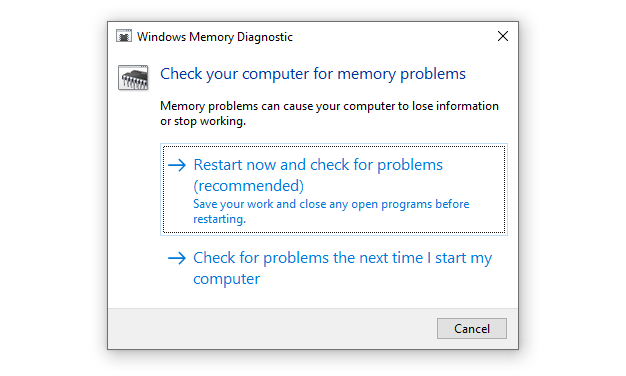Ram Test Windows 7 64 Bit
How to Examination RAM: Making Certain Bad Memory Isn't Crashing Your PC

Your computer's RAM is key to its operation. Explained simply, RAM (opens in new tab) is your computer's short-term retention, which information technology uses to work on its electric current task. Even so, like any computer function, even the best RAM (opens in new tab) can break, and so yous'll desire to know how to test whether your memory is stable or not.
I of the first signs of memory going bad is blueish screens of death (BSODs). Memory bug often brand themselves hands noticeable by their quickly increasing severity. At first, you'll but rarely experience crashes, and the arrangement will all the same be workable. Only before you lot know information technology, the system will crash during outset-up. Therefore, it'southward important to identify the problem quickly.
There are multiple ways of testing your computer's memory. We'll comprehend a few of them today.
How to Test RAM

One option preferred by u.s.a. at Tom's Hardware is HCI Design'due south MemTest (opens in new tab). The skilful thing well-nigh this is y'all don't take to any pre-booting and there are no directions. You just run it.
The next easiest way to exam your memory is with Windows ten (opens in new tab)'south built-in Memory Diagnostic tool.
1. Search for "Windows Memory Diagnostic" in your start menu, and run the application.

2. Select "Restart now and check for problems." Windows will automatically restart, run the test and reboot dorsum into Windows.

iii. Once restarted, await for the result bulletin. This may take a few moments to appear as the arrangement starts up. Exist patient. Information technology will bear witness upward, but keep an heart out for it, as it volition disappear over again quickly.

How to Exam RAM With Passmark Memtest86
PassMark'due south Memtest86 is a reliable tool for testing memory without the demand for an operating system, meaning it will piece of work on Windows machines equally well as Linux computers. It runs off a bootable USB stick, and although it looks complicated, information technology is very straightforward to apply.
1. Download Passmark Memtest86 (opens in new tab).
2. Extract the contents into a folder on your desktop.
3. Insert a USB stick into your PC. Support whatever data on it, as Passmark's tool will format the USB stick.
four. Run the "imageUSB" executable.
five. Select the correct USB drive at the top, and press 'Write'

half-dozen. Double-check whether everything is correct before proceeding. Writing volition take a few moments, depending on the speed of your USB stick.
7. Restart your computer, and enter the kick bill of fare through pressing F2, Del, F8, F10 or whichever fundamental your system uses. It will say on your post screen.
eight. Kick off the USB stick.
nine. Press "Config."

x. Select "(Southward)tart Exam" in the Memtest86 home screen.

Now let the application run the test until completion or until errors appear. You tin monitor the progress of the test at the top of the screen.
Depending on your memory size, testing tin have from 20 minutes to a few hours. If errors announced, in that location is no bespeak in continuing testing. A screen with errors looks like this:

What If My RAM Is Bad?
If you lot didn't become any errors: congratulations. Your memory is in working order. You can either rest assured or, if yous are having crashes, continue troubleshooting to figure out what else may be the cause at present that RAM issues are ruled out.
If y'all practice go errors, then also congratulations: you lot've establish the culprit of your crashes. In 95% of cases, the only mode to fix memory issues is to buy new RAM (opens in new tab) or supercede it. If you lot accept multiple RAM kits, exist sure to test them independently to figure out which is causing bug and send it in for warranty. Luckily, a lot of RAM kits come with a lifetime warranty these days.
But in that location are three things you can practice to effort to go rid of these RAM-caused problems.
The first is to ensure that your RAM is running at the correct clocks for your system. All retentivity has its speed and timings written on its label or packaging, and you want to make certain that it runs at these speeds using the XMP profiles in your BIOS (opens in new tab). It hardly e'er happens, only it's possible that the memory was set to run faster than it was capable of, which would naturally lead to errors.
If setting the right XMP profile in your BIOS doesn't help, another trick that sometimes works is to underclock your retentiveness -- i.due east. run it slower than the intended speeds. You tin do this by reducing the frequency and backing off on the timings. However, this is often a temporary measure out because if the RAM has degraded, the errors are probable to return presently.
Lastly, note that certain platforms do not play nicely with all memory configurations. If y'all're running an especially high memory frequency, be certain to check whether this is supported by your CPU (opens in new tab) and motherboard (opens in new tab). Out-of-spec combinations will make it appear like the memory is broken, when in actuality the memory controller on your CPU is unable to handle the RAM'southward loftier frequencies.
Ram Test Windows 7 64 Bit,
Source: https://www.tomshardware.com/how-to/how-to-test-ram
Posted by: parksmusere1980.blogspot.com


0 Response to "Ram Test Windows 7 64 Bit"
Post a Comment